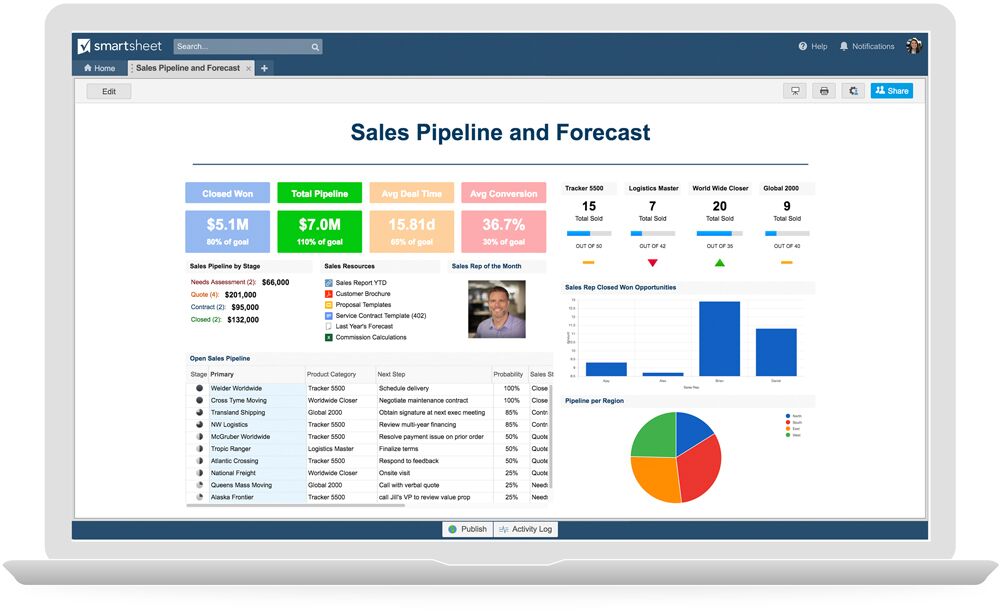|
by Stephen Danos on March 20, 2018 Executive dashboards are powerful business tools that can connect leaders to their entire organization through insightful data streams. Embracing critical layers of visibility can make businesses more competitive by strengthening connections between C-level leaders, managers, individual contributors, and their stakeholders. In addition, company-wide visibility into key performance indicators (KPIs) and business critical information help connect employees to the company’s strategic vision. Executive dashboards deliver the right information from different departments, helping business leaders make the best decisions. Using Smartsheet Dashboards, executives can save time and assess performance against initial strategies, enabling them to test hypotheses with an eye on continuous improvement. Once they get their teams thinking in organized, data-driven terms, executives could see boosted employee performance, increased profitability, and less procedural waste. This strategic simplification connects meaningful metrics and data — accessible on both desktops and mobile devices — and moves teams from insight to action. While you can customize executive dashboards in a variety of ways, below are three categories that will help drive better organizational alignment, consolidate insights for faster decision making, and help people stay organized and informed across teams. Strategic Dashboards for Organizational AlignmentIt can be challenging for business leaders to get real-time data themselves. Strategic dashboards improve visibility by displaying KPIs with birds-eye-view visualizations. With Smartsheet, executives can get access to performance metrics that matter to their company. To ingrain habitual transparency at all levels, team leaders can display their KPIs on larger monitors or screens, so passers-by can see the performance in real time. Here are two examples of strategic dashboards:
Tracking performance over time with strategic dashboards enables teams to prepare for upcoming milestones and plan countermeasures when there is a need for strategic pivots. Analytical Dashboards to Consolidate InsightsAnalyzing historical trends can lead to continuous improvement from the executive suite down to the team level. Using an analytical dashboard, you can drill down into various performance metrics and KPIs. With dashboards, you can see essential information — whether it’s revenue growth, lead generation and conversion performance, or profit margins — via various visual representations. Analytical dashboards are typically more intricate than strategic or operational dashboards, as they are a composite of data collection over customized periods of time. Visualizing data with charts optimizes your ability to spot data trends with a simple eye test. Trends tell you what is happening over time in your business, point to potential root causes, and can be used to support decision making. Operational Dashboards to Stay InformedOperational dashboards provide reliable visibility into daily business processes and how well teams are performing. Whether on a task-by-task basis or aligning to broader company objectives, having access to real-time information empowers teams to take immediate actions, identify and share new opportunities, and exchange key learnings. Here are three examples of dashboards people can create in this category:
Smartsheet executive dashboards can be comprised of data insights and resources from around your entire organization, connecting disparate business groups into a cohesive ecosystem. Having access to the right information at the right time gives you a strategic advantage, as there is less time wasted requesting data reports or chasing down stakeholders for corroboration. All in all, visibility into departmental health leads to improvement opportunities, better-informed decision making, and faster execution. To learn more about what Smartsheet Dashboards can do for your business, watch the video below: Source: Smartsheet Blog
|
|
Care line: +603-9212 0157
|
Leave us your inquiry |
|
This company is registered with the Ministry of Finance, Malaysia.
Equip your organisation with digital solutions & training that inspire innovation and joy at work. Copyright © 2024 57Network Consultancy Sdn. Bhd. Company Registration number : 202001020346 (1376666-K) All rights reserved. |









